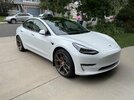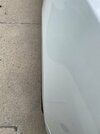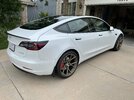I have an M3P arriving shortly and I am trying to get together all my mods before it arrives.
Doing 35% all the way around and PPF on front end day 1.
Where I have questions is suspension/wheels/tires. i have been reading on this for days and everyone seems to have different assessments of what can/should be done here
Ideally, I would keep the 20x9s and put 275/30/zr20 P4S tires on with ohlins and sway bars.
Many people act like 245/255 are the absolute largest that can be done on the front. people also say that you need 9.5-10.5 inch rim for a 275. I can totally understand if I were wanting perfection, I’d do a 9.5, but that adds ~5k to the car (not worth in IMO).
The P4S specs a 9-10 inch rim in this size (275/30/20). I have a car with factory P4s at 9.5, so not apples to apples to apples but still not 10+
Also, there is a YouTube video of someone with a stock white 3 with 275/30/20 on his stock 20x9s with no rubbing. I do not understand why people act as if you have to grind on suspension parts to fit 275s or have extreme offsets. Has something changed on the m3 suspension? Are people all taking about the old 8.5s?
I also see rim sets sold staggered… like 275/245 (10/9) And people on YT doing this. Why would you want to run a staggered setup on this car? It seems like AWD would prefer a square setup
From what I see, the 275s would fit, and add no mass (comparing Tesla tire weight to p4s)… is there some great compelling reason to not do 275? Alternately, if I would choose to waste the 5k on rims, I could cut ~9lbs per corner and have a more “ideal” platform for 275s… is that worth the money? Of course, if I find the 9s handle like complete trash, I could always do wheels later… I’m not sure why so few have tried this
Oh, and if my reasoning is needed for the suspension, I am looking for better handling (not softer ride), and a car that doesn’t look like it’s on stilts. Even 275s will look small in the rear, imo. I don’t care whatsoever about range. I do possibly care about warranty issues, but not with the parts I replace because that’s just obvious.
Doing 35% all the way around and PPF on front end day 1.
Where I have questions is suspension/wheels/tires. i have been reading on this for days and everyone seems to have different assessments of what can/should be done here
Ideally, I would keep the 20x9s and put 275/30/zr20 P4S tires on with ohlins and sway bars.
Many people act like 245/255 are the absolute largest that can be done on the front. people also say that you need 9.5-10.5 inch rim for a 275. I can totally understand if I were wanting perfection, I’d do a 9.5, but that adds ~5k to the car (not worth in IMO).
The P4S specs a 9-10 inch rim in this size (275/30/20). I have a car with factory P4s at 9.5, so not apples to apples to apples but still not 10+
Also, there is a YouTube video of someone with a stock white 3 with 275/30/20 on his stock 20x9s with no rubbing. I do not understand why people act as if you have to grind on suspension parts to fit 275s or have extreme offsets. Has something changed on the m3 suspension? Are people all taking about the old 8.5s?
I also see rim sets sold staggered… like 275/245 (10/9) And people on YT doing this. Why would you want to run a staggered setup on this car? It seems like AWD would prefer a square setup
From what I see, the 275s would fit, and add no mass (comparing Tesla tire weight to p4s)… is there some great compelling reason to not do 275? Alternately, if I would choose to waste the 5k on rims, I could cut ~9lbs per corner and have a more “ideal” platform for 275s… is that worth the money? Of course, if I find the 9s handle like complete trash, I could always do wheels later… I’m not sure why so few have tried this
Oh, and if my reasoning is needed for the suspension, I am looking for better handling (not softer ride), and a car that doesn’t look like it’s on stilts. Even 275s will look small in the rear, imo. I don’t care whatsoever about range. I do possibly care about warranty issues, but not with the parts I replace because that’s just obvious.





